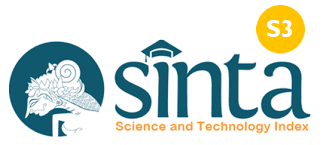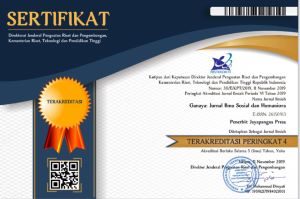Eksistensi Pasraman Dalam Menanamkan Nilai Moral Bagi Umat Hindu
DOI:
https://doi.org/10.37329/cetta.v3i2.450Keywords:
Pasraman, Moral EducationAbstract
Bali Island as a foreign tourist destination, aware or not possible to be affected by the interaction with tourists who come to Bali and cause acculturation of foreign culture with local culture. Acculturation of positive culture enriches local culture while the influence of negative foreign culture can damage, mencedrai and even shift the existence of local culture, for that the necessary antidote to negative foreign culture through education in pasraman. The aim of this study. describe the existence of pasraman Brahma Vidya Samgraha Penarungan Village, Buleleng Regency; Describe the implementation of education in Pasraman Brahma Vidya Samgraha; Penarungan Village, Buleleng Regency; Describing the planting of moral education in the Brahma Vidya Samgraha Penarungan Village, Buleleng Regency. This research uses descriptive-qualitative method with a phenomenological approach. The findings in this study of the existence of Pasraman Brahma Vidya Samgraha are an acculturation of the education system that is the traditional education system and the modern or contemporary education system. The implementation of ceremonies (rituals) through the routine of making ceremonial facilities carried out in pasraman. Conclusion: Pasraman Brahma Vidya Samgraha is a type of non-formal education acculturated with the education system of Color Dormitory Dharma with the transformation of the upanisad learning model based on vedic culture; Pasraman Brahma Vidya Samgraha conducts adult learning (andragogy) with teaching programs in accordance with the level of basic education, middle level education and primary level of education, by applying a varied upanisad learning model; Pasraman Brahma Vidya Samgraha implements moral values in Pasraman as a spiritual commitment through the mutual assistance activities of the sisya in the process of making ceremonies and conducting ceremonies in Pasraman.
References
Atyani, N. (2019). Peran Pasraman Sebagai Wahana Penguatan Karakter Gemar Membaca Pada Anak Di Desa Mulya Sari Kecamatan Negeri Agung Kabupaten Way Kanan.
Kadjeng, I N. (2009). Sarasamuccaya. Surbaya: Paramita
Köttgen, L. et al. (2016) ‘Integrating Blended Learning – On the Way to an Excellent Didactical Method-Mix for Engineering Education’, in Automation, Communication and Cybernetics in Science and Engineering 2015/2016, pp. 339–352. doi: 10.1007/978-3-319-42620-4_27.
Lester, L. and Mander, D. (2015) ‘The Role of Social, Emotional and Mental Wellbeing on Bullying Victimisation and Perpetration of Secondary School Boarders’, Journal of Psychologists and Counsellors in Schools, 25(2), pp. 152–169. doi: 10.1017/jgc.2014.28.
Martin, A. J. et al. (2014) ‘Boarding School, Academic Motivation and Engagement, and Psychological Well-Being’, American Educational Research Journal, 51(5), pp. 1007–1049. doi: 10.3102/0002831214532164.
Martin, A. J. et al. (2015) ‘Motivation, engagement, and social climate: An international study of boarding schools’, Journal of Educational Psychology, 108(6), pp. 772–787. doi: 10.1037/edu0000086.
Miles & Huberman.(2014). Analisis Data Kualitatif.Jakarta: Universitas Indonesia.
Naradha, S. (2004). Ajeg Bali Sebuah Cita-Cita. Denpasar: Bali Post.
Prabavananda,Swami. (2006). Agama Weda & Filsafat. Surabaya: Paramita.
Rao, D. N. N. (2010) ‘Knowledge Transfer for Spiritual Enlightenment: Master-Disciple Tradition in Ancient India’, Information Studies, 16(4), pp. 215–228.
Sagala, S. (2015) ‘MANAJEMEN DAN KEPEMIMPINAN PENDIDIKAN PONDOK PESANTREN’, JURNAL TARBIYAH, 22(2), pp. 205–225.
Satori, Djam’an, Aan Komariyah. (2010). Metodologi Penelitian Kualitatif. Bandung: Alfabeta.
Sila, I. M. (2016). Revitalisasi Manajemen Pasraman Dalam Menumbuhkan Sikap Revolusi Mental Secara Berkelanjutan Pada Pasraman Di Desa Puhu Kacamatan Payangan. Widya Accarya, 6(2).
Subagia, I. N. (2017). Keberadaan Pasraman Sebagai Penguatan Budaya Lokal Dikaitkan Dengan Peraturan Pemerintah Nomor 55 Tahun 2007. VIDYA SAMHITA: Jurnal Penelitian Agama, 2(2).
Suhardana, K.M. (2007). Tri Kaya Parisuda. Surabaya,Paramita.
Trammell, M. G. (1999) A study of the effects of spiritual commitment and intervention on communication apprehension, ProQuest Dissertations and Theses. Available at: http://search.proquest.com/docview/304544932?accountid=14553%5Cnhttp://openurl.library.uiuc.edu/sfxlcl3?url_ver=Z39.882004&rft_val_fmt=info:ofi/fmt:kev:mtx:dissertation&genre=dissertations+&+theses&sid=ProQ:ProQuest+Dissertations+&+Theses+Full+Text&atitle=.
Undang-Undang Republik Indonesia No.20 Tahun 2003 tentang Sistem Pendidikan Nasional.
Widnya, I K. (2017). Bianglala Peradaban Hindu. Denpasar: ESBE Buku.
Yuli, N. G., Haningsih, S. and Adikrishna, R. (2011) ‘Boarding School : A Preliminary Research in’, International Jornal of Engineering & Technology, 11(4), pp. 156–163.
Downloads
Published
How to Cite
Issue
Section
License
An author who publishes in the Cetta : Jurnal Ilmu Pendidikan agrees to the following terms:
- Author retains the copyright and grants the journal the right of first publication of the work simultaneously licensed under the Creative Commons Attribution-ShareAlike 4.0 License that allows others to share the work with an acknowledgement of the work's authorship and initial publication in this journal
- Author is able to enter into separate, additional contractual arrangements for the non-exclusive distribution of the journal's published version of the work (e.g., post it to an institutional repository or publish it in a book) with the acknowledgement of its initial publication in this journal.
- Author is permitted and encouraged to post his/her work online (e.g., in institutional repositories or on their website) prior to and during the submission process, as it can lead to productive exchanges, as well as earlier and greater citation of the published work (See The Effect of Open Access).
Read more about the Creative Commons Attribution-ShareAlike 4.0 Licence here: https://creativecommons.org/licenses/by-sa/4.0/.





